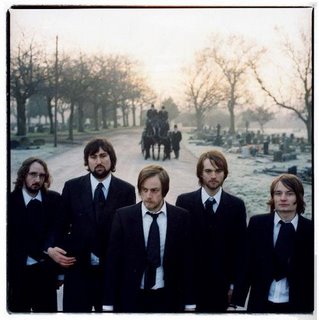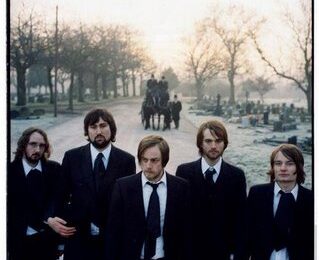The music video has, in recent years, become a staid artform. Labels bat interesting pitches back to production companies with a demand to simplify the concept to a performance video, while those that do get made might well end up costing more than even an album will ever recoup in sales. That the one of the biggest indie video hit of recent times was the one where The Cribs persuaded a young lady to bound around with her knockers out surely speaks volumes.
Credit is due, then, to iLiKETRAiNS, who’ve doggedly sailed against the prevailing wind to come up with an aesthetic that has self-produced, and wildly ambitious, videos at its heart. They’ve done this by ignoring conventional wisdom to create their own world, populated by model characters acting in remarkable stop-frame animation reminiscent of the Brothers Quay or Jan vankmajer gone Morph.
These short films nudge iLiKETRAiNS’ elegiac anthems into an unexpected personal realm, emphasising the band’s worth as more than another bunch of serious young post rock gentleman with a fascination for the more obscure corners of British history. For instance, ’Terra Nova’, a track that dealt with the Scott’s doomed 1912 Antarctic expedition, was given added gravitas by the video that accompanied it: who would have thought that the demise of a small bundle of cloth called Captain Oates could be so affecting.
iLiKETRAiNS – ‘Terra Nova’
Now, with the release of a DVD film to accompany last year’s excellent Elegies to Lessons Learnt long player, iLiKETRAiNS have most completely realised their vision. The film connects the various stories that make up Elegies… (the plague dead of the Derbyshire village of Eyam, the assassination of Prime Minister Spencer Perceval by John Bellingham, the delusionary Donald Crowhurst, who in 1968 walked off his yacht into the Atlantic during round the world race) through an unfortunate plasticine figure who moves back and forth through history, taking the sundry narratives of the album’s characters onto his carefully moulded shoulders. It’s a compelling, and at times moving, audiovisual success, the everyman figure sharpening the album’s mournful tone. Even better, the disc also features the original essays written by the band to furnish some background information to journalists reviewing the album that unfortunately were not included in the original commercial release.
iLiKETRAiNS kindly let The Quietus reproduce the essay for ’We Go Hunting’, the track based on Samuel Parris, the Massachusetts preacher and instigator of the Salem Witch trials .
We Go Hunting
By iLiKETRAiNS
Samuel Parris (1653-1720)
Samuel Parris died in Wayland, Massachusetts on 27th February 1720
Samuel Parris was born in London in 1653 to Thomas Parris, a cloth merchant who, in the 1650s, purchased land in Barbados. In the 1660s, Samuel was sent to Massachusetts to the University at Harvard, where he was in 1673 when his father died. Parris inherited his father’s land on the island and, after he had graduated from his studies, moved there with the intention of maintaining the sugar plantation that his family held there. He bought two slaves to manage named John and a woman named Tituba.
Later, he leased out the plantation and settled in Bridgetown, the island’s capital, where he became established as a creditor for other plantation owners.
In 1680, he returned to Boston accompanied by two household slaves, and that winter he married a New England woman named Elizabeth Eldridge. A year after the wedding, Elizabeth gave birth to Thomas, their first child. A year later, their daughter Betty was born, and five after that, a further daughter, Susahanna. All this time, the plantation on Barbados was providing Parris and his family with a steady income, but he was starting to become dissatisfied with the course of his life.
iLiKETRAiNS – ‘We Go Hunting’
Turning his thoughts to a religious life in 1686, he began to preach at local churches, and then, when Susahanna was born, spoke to the village of Salem about becoming their formal minister. They accepted. He moved into the parsonage with his family and started to undertake his ministerial duties in July 1689. He soon antagonised the villagers, though, being seen as egotistical and greedy, despite his Puritanical sermonising. In October of 1691, some of the villagers stopped making the usual contributions to the minister’s salary in protest. Parris in return preached that evil was taking control of the village, and was stirring up the feelings against him and the church, which were the work of Satan.
In 1692, Parris’ elder daughter Betty, who was nine years old, and her 11 year old cousin Abigail Williams who also lived in the parsonage, started to suffer from strange fits. They would scream and make strange noises, and act very eccentrically, and they complained of pricking or cutting pains. When Betty’s father got up to preach, the girls would cover their ears as if dreading to hear his words. The doctor William Griggs could find nothing medically wrong with them. The pastor of nearby Beverley, John Hale, suggested the effects of witchcraft. Soon two other girls in the village, Ann Putnam Jr and Elizabeth Hubbard, were also suffering from the symptoms.
Three women were quickly accused of being responsible for the girls’ conditions, including Parris’ servant Tituba, along with two other non-churchgoing villagers. Tituba had been beaten by her master until she admitted her role, and confessed that the other two women were her accomplices. They found themselves in front of local magistrates on 1st March, where they endured several days of questioning, before being imprisoned. More arrests followed in March, including that of the four-year-old daughter of one of the original suspects, who was manipulated by the magistrates implicating her own mother, then confessing to being a witch herself in order to see her parent again. Others accused were upstanding members of the community, for example Martha Corey, who found herself at the mercy of the authorities after being overheard stating her disbelief of the afflicted girls stories. Many more arrested in April, both women and men. Relatives of those already accused also found themselves suspected. Villagers saw accusation as a way of settling disputes on other matters, such as when the former minister George Burroughs was accused by enemies from his old congregation who believed he owed them money. The final arrests for the time took place on April 30th.
In May, the Governor of Massachusetts, William Phipps, returned from England to find the colony in this state of disarray. He appointed William Stoughton to set up a court to try the accused, apart from two who had already died in prison, including the young girl. That month saw further arrest warrants raised, until in total there were 62 people to be dealt with in what became known as the Salem Witch Trials. The first case came before the court on June 2nd, as Bridget Bishop was found guilty. She was executed on June 10th. In total 19 people were executed on four separate days, an 80 year old farmer was tortured to death when he refused to give a plea, and one more died in prison.
At the end of October, Governor Phipps prohibited the arrest of any more people on charges of witchcraft. Many of those in prison were released and the court was dissolved. A more regular court was set up in November to try the remaining cases, which was run more rationally than Stoughton’s, and at the start of 1693, 49 of the remaining 52 prisoners were released without charge. Following the trials, Parris’ church brought charges against him for his part in fanning the flames of the witch hunt. As the dissatisfaction amongst his congregation, he finally apologised for what he had done in 1694. This did little to appease them, however, and in 1697 he was driven out of the village. Parris remained a preacher, accepting a position in Stow. He later moved on again, to Concord, Dunstable and finally Wayland, all other towns in Massachusetts. It was in Wayland that Parris was to die in 1720.




